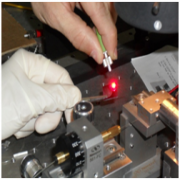Multiexction generation in at the nanometer scale.
Carrier multiplication by multiexction generation (MEG) is a process where several charge carriers are generated upon the absorption of a single photon in semiconductors. This process is of great technological ramifications for solar cells and other light harvesting technologies. For example, it is expected that when more charge carriers created shortly after the photon is absorbed, the larger fraction of the photon energy can successfully be converted into electricity, thus increasing the device efficiency. So far, consensus on MEG efficiencies has not been achieved, alluding to experimental and theoretical controversies. In light of the above, we have developed a unified approach to the treatment of MEG in nanocrystals. Our approach is based on the Green's function formalism, which in principle, leads to an exact description of MEG. It accounts for the screened Coulomb couplings between single and biexcitons, and between the exciton manifolds themselves. In addition, the formalism allows for the description electron-phonon couplings that are crucial for a complete description of MEG. The direct/indirect absorption and coherent/incoherent impact ionization mechanisms, often used to describe multiexciton generation in nanocrystals, were rederived from the unified theory as certain approximations. In addition, two new limits were described systematically - the weak Coulomb coupling limit and the semi-wide band limit. We showed that the description of multiexciton generation in nanocrystals can be described as incoherent process and discussed the scaling of multiexciton generation with respect to the photon energy and nanocrystal size. Illustrations include three prototype systems: CdSe, InAs and silicon quantum dots. We have also address recent experiments reporting on highly efficient multiplication of electron-hole pairs in carbon nanotube photodiodes at photon energies near the carrier multiplication threshold (twice the quasi-particle band gap). We proposed a detailed mechanism based on carrier dynamics and impact excitation resulting in highly efficient multiplication of electron-hole pairs. We find that there is an onset temperature for MEG in agreement with experiments and predict its length dependence.






